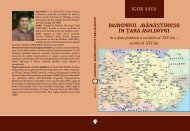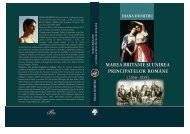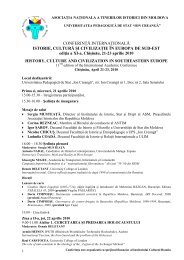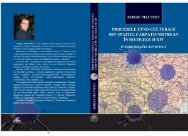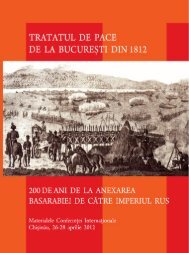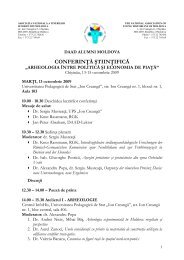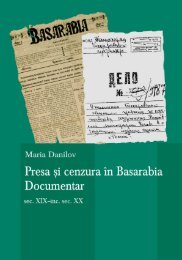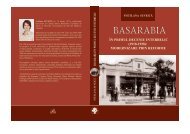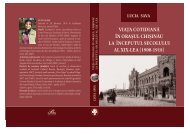Publicatie cu continut integral - Asociatia Tinerilor Istorici din Moldova
Publicatie cu continut integral - Asociatia Tinerilor Istorici din Moldova
Publicatie cu continut integral - Asociatia Tinerilor Istorici din Moldova
You also want an ePaper? Increase the reach of your titles
YUMPU automatically turns print PDFs into web optimized ePapers that Google loves.
omâni în timpul regimului comunist a reflectat politica partidului muncitoresc român, apoi a partidului<br />
comunist român faţă de urss. Începuturile desprinderii de subordonarea totală faţă de Moscova coincid <strong>cu</strong><br />
prima definire a <strong>cu</strong>lturii, mărturie arheologică a românilor ca etnie diferită de slavi. Formularea deplină a specifi<strong>cu</strong>lui<br />
etnic românesc al <strong>cu</strong>lturii Dridu s-a petre<strong>cu</strong>t în perioada de liberalizare <strong>din</strong>tre 1964-1971, iar excluderea<br />
slavilor sau bulgarilor <strong>din</strong>tre purtătorii <strong>cu</strong>lturii corespunde <strong>cu</strong> politica de izolare şi de omogenizare a societăţii<br />
impusă de regimul comunist în perioada sa finală. Rezervele unor arheologi faţă de această interpretare excesivă<br />
au fost exprimate <strong>cu</strong> prudenţă.<br />
Ce se poate spune astăzi despre <strong>cu</strong>ltura Dridu ? În primul rând, datarea începutului ei în prima jumătate a secolului<br />
al IX-lea este asigurată de o monedă emisă de Nikephor I (802-811), descoperită în aşezarea de tip Dridu<br />
de la Şirna, jud. Prahova 1 . Contrar a ceea ce se crede adesea, <strong>cu</strong>ltura Dridu nu a fost răspândită pe tot teritoriul<br />
României, deoarece tipul B de ceramică nu a fost descoperit în <strong>Moldova</strong> şi nici în cea mai mare parte a Transilvaniei.<br />
Doar existenţa acestui tip defineşte <strong>cu</strong>ltura Dridu, deoarece tipul A (<strong>cu</strong> decor incizat) este o variantă locală a<br />
ceramicii donau-typus, care este răspândită în toată Europa centro-orientală. 2 Cultura Dridu a fost specifică pentru<br />
regiunea Dunării de Jos, fără a putea fi asociată în mod exclusiv <strong>cu</strong> o anumită etnie, slavă, bulgară sau română.<br />
Toate cele trei etnii au contribuit la formarea ei, sub influenţa civilizaţiei bizantine. De fapt, această <strong>cu</strong>ltură a exprimat<br />
un anumit nivel de civilizaţie şi de viaţă economică, specific ariei unde s-au putut difuza produsele<br />
atelierelor de ceramică <strong>din</strong> zona dunării de jos . Tocmai de aceea <strong>cu</strong>ltura Dridu nu a pătruns la sud de Munţii<br />
Balcani, unde influenţa bizantină mai puternică a condus la dezvoltarea unei civilizaţii materiale mai avansate<br />
şi, în orice caz, diferite. Cultura Dridu, ca şi, mai târziu, civilizaţia oraşelor <strong>din</strong> Paradunavon, a fost purtată de<br />
populaţia de diferite origini etnice de la periferia sferei de influenţă a civilizaţiei bizantine, situată într-o zonă de<br />
contact <strong>cu</strong> lumea stepelor nord-pontice.<br />
summarY<br />
After the establishment of the Soviet domination in Romania, the archaeological researches were directed to<br />
the discovery of any finds able to prove the existence of a considerable Slavic component in the Romanian ethnogenesis.<br />
The changes oc<strong>cu</strong>rred in the home policy after 1955 led however to a partial recovery of the national<br />
values, which also meant a revived concern for the ethnogenesis, a problem studied by a special commission of<br />
the Academy. The excavations started at Dridu in 1956 offered a support for this new approach, because the material<br />
<strong>cu</strong>lture defined by this settlement was distinguished by I. Nestor from that used by the Slavs. This theory<br />
expressed in 1958 and more clearly in 1964 was a consequence, conscious or not, of the changes oc<strong>cu</strong>rred in the<br />
official attitude toward the Romanian history, because it defined Romanians as a different ethnicity than the surroun<strong>din</strong>g<br />
Slavs. Its definitive formulation coincides with the independency trend of the Romanian policy in 1964,<br />
while the exclusion of the Slavs or Bulgarians from the bearers of the Dridu <strong>cu</strong>lture (sustained especially by E.<br />
Zaharia) was contemporary with the policy of homogenization of the late years of the Communist regime. The<br />
Nestor-Zaharia theory became official, but not all the Romanian archaeologists supported it. Notable exceptions<br />
were C. Daicoviciu and M. Comşa. The way how the Dridu <strong>cu</strong>lture was interpreted by the Romanian archaeologists<br />
during the Communist regime has reflected the policy toward USSR . Now, the ethnic interpretations of this<br />
<strong>cu</strong>lture are obsolete. In fact, this <strong>cu</strong>lture has expressed a certain level of civilization and of economic life, specific<br />
for the area were the products of the Lower Danubian pottery workshops were spread.<br />
Bibliografie<br />
ARVINTE, V., 1966, Formarea limbii şi poporului român în lumina cercetărilor recente, “Anuar de lingvistică şi istorie<br />
literară”, Iaşi, 17, 13-32.<br />
BARZU, L., 1980, La continuité de la création matérielle et spirituelle du peuple roumain sur le territoire de l’ancienne<br />
Dacie, Bucarest.<br />
BARZU, L., BREZEANU, S., 1991, Originea şi continuitatea românilor. Arheologie şi tradiţie istorică, Bu<strong>cu</strong>reşti.<br />
1 Şt. OLTEANU 2002, O monedă de la împăratul Bizanţului nichifor i descoperită la şirna, jud. Prahova şi importanţa ei pentru datarea<br />
primei faze a <strong>cu</strong>lturii “Dridu”, în “Cercetări numismatice. Muzeul Naţional de Istorie”, 8, 173-175.<br />
2 P. DIACONU, extension..., 108–110.<br />
3 Idem, Problema..., 129.<br />
– –



